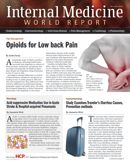Publication
Article
Internal Medicine World Report
Effects of Female Hormones on Cigarette Cravings
Author(s):
Smoking rates were found to be higher in men than in women, but decreasing in both sexes – reports had indicated the rates may be increasing in young women. Previous studies have shown women become addicted to nicotine faster and have greater difficulty quitting smoking due to more intense cravings when stimulated by cues than men.

Smoking rates were found to be higher in men than in women, but decreasing in both sexes — reports had indicated the rates may be increasing in young women. Previous studies have shown women become addicted to nicotine faster and have greater difficulty quitting smoking due to more intense cravings when stimulated by cues than men. Women have greater difficulty quitting during the follicular phase of their menstrual cycles (low hormone levels, days 3 through 8) than during the luteal phase (higher hormone levels, days 16 through 28).
A small study in Psychiatry Journal explored the differences between the sexes with heightened attention to the follicular and luteal menstrual cycle phases. Thirty four current smokers (19 women with regular menstrual cycles and 15 men) with no comorbid psychiatric conditions were given functional MRIs. Menstrual cycle timing was determined via self-reporting and blood hormone assays.
Brain activation patterns in women varied across their menstrual cycles.
· During the luteal phase, the researcher saw only right hippocampal activation consistent with memory recollection when women faced cigarette-related cues.
· During the follicular phase, areas in the frontal, parietal and temporal lobes—more areas than observed in the luteal phase—were activated.
Increased estrogen has been associated with increased cravings but some studies have found the reverse to be true. The statistical significance between hormone levels and strength of self-reported cravings was too weak to be significant (possibly due to the small number of participants). Psychological and sociological factors also confounded the hormonal effects.
Cue-elicited cravings were similar in both sexes. The participants smoked a cigarette 30 to 40 minutes before receiving the functional MRI to ensure consistency. However, differences between the sexes are greater during abstinence longer than 12 hours (as shown in other studies).
This study was unable to determine hormonal influences on cravings due to its small population size and participants’ recent smoking. The study authors advocated future studies should investigate the sex-specific psychological and sociological factors. The authors also recommended sex-specific smoking cessation programs be implemented.






